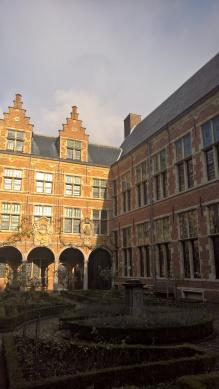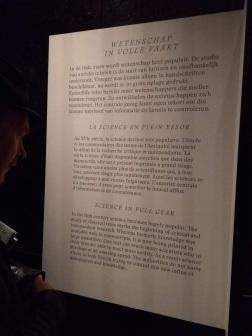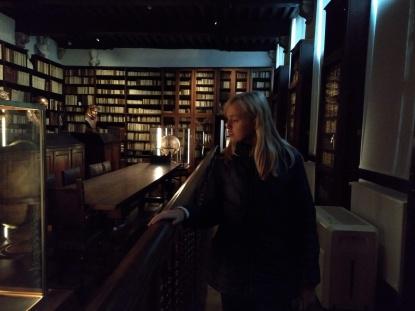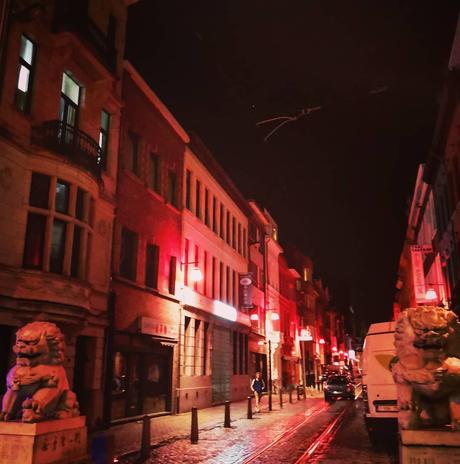NEW EXHIBITION AT PLANTIN- MORETUS SHOWS THE CITY’S IMPORTANT ROLE IN PAVING THE WAY FOR THE ENLIGHTENMENT.

A trip to the Plantin Moretus museum (left) provided the inspiration for this guest post by Daniel McBrearty.
Are you deluged by data, fazed by fake news, or stressed out from trying to find a teaspoon of facts in a sea of information? What you need is some historical perspective, and Antwerp’s Plantin Moretus Museum is the perfect place to find it …
Christophe Plantin, a native Frenchman and Humanist who became a powerful Antwerp businessman, could reasonably be called the Steve Jobs of the 16th century. He founded one of the three most important printing presses in Europe, and by 1550 he was one of the biggest publishers in the world, with sixteen operational presses and employing fifty people. The technology he used, along with much of his considerable wealth and countless books, are lovingly preserved in the Plantin Moretus Museum, on the Vrijdagmaarkt.
As well as physical artefacts, the Museum has done a wonderful (and timely, given the impact of the internet on our own times) job of placing Moretus’s considerable influence in a historical context. Their current exhibition, “Baroque Book Design”, fuses the work of Rubens and others -as part of the city’s the publishing industry- with insightful observation on social conditions of the time.

After Plantin’s death, the business was taken over by Jan Moretus, his son-in-law, and the family continued to dominate European publishing for the next 150 years. The printing press was a real challenge to the Catholic church, which had relied on the inability of an illiterate public to interpret the Bible without the help of priests. Gutenberg’s invention broke forever that monopoly of belief.
Books – now twenty times faster to produce, and much cheaper- became more widely available. An information revolution as big as our own, was underway. Schools of language, medicine, science and religion serviced a knowledge-hungry public, and created huge demand, which the Plantin-Moretus family was more than willing to supply. With a technology based on pouring lead into stamped copper moulds to make type, which was then manually assembled into pages, their team of craftsmen produced, over several years, a staggering 500,000 copies of one small book of language exercises – this being just one of countless volumes from the house.
Revolutions of belief soon led to violence, followed by a formidable backlash from the Vatican. Europe was beset by rebellion and repression. Catholic Spain and the Protestant Netherlands went to war, and Antwerp caught right between them. As well as Bibles in many languages, The Plantin Press had been publishing translations of Latin and Greek philosophers, and works which spread new scientific research. But a crackdown from the church forced an end to the dissemination of such dangerous ideas. The Plantin-Moretus family, however, were clearly astute diplomats as well as businesspeople, managers, and technicians. Not only did they survive, they became at various times, official printers and typographers to the Dutch, the Spanish and the Church.

Then, as now, the real benefits of the new technology were not immediately felt by common people. In fact it took several hundred years, and much argument and bloodshed, before they led to real improvement in living conditions.
As well as his beautiful drawings and engraved copper plates, the Museum possesses many paintings by Rubens, who was one of the favorite illustrators used by the Moretus family. Everywhere you feel his portraits gazing at you. His subjects included (as well as the nobility and the clergy) workers at the house. For me, they show an honest astuteness which lesser artists lack – rather like a modern artist such as Milo Manara, he has the rare ability to capture something of the soul of his subjects.
Entrance to the Museum is inexpensive (6€ or 8€ depending on age), or free with an A-kaart. Staff are friendly and helpful, and on a weekday the space is fairly uncrowded. You can take refreshment in one of Vrijdaagmaarkt’s excellent cafes and restaurants and then stroll back in with no problem. Photography is permitted without flash.
So, if the internet revolution has left you dazed and confused, or if you simply fancy an entertaining, thought-provoking few hours, I highly recommend Plantin-Moretus Museum. After all, we’ve been here before, and it helps to be reminded of that.
Daniel McBrearty is a father, jazz clarinet and sax player, singer-songwriter and electronics whiz who has made his home in Antwerp since 2001.
Music website :www.danmcb.com
Audio electronics : www.mcbeeaudiolabs.com
Find & Follow Nessascityblog
ON: Facebook (Events in Antwerp: in conjunction with London Calling)
Twitter & Pinterest & Instagram


